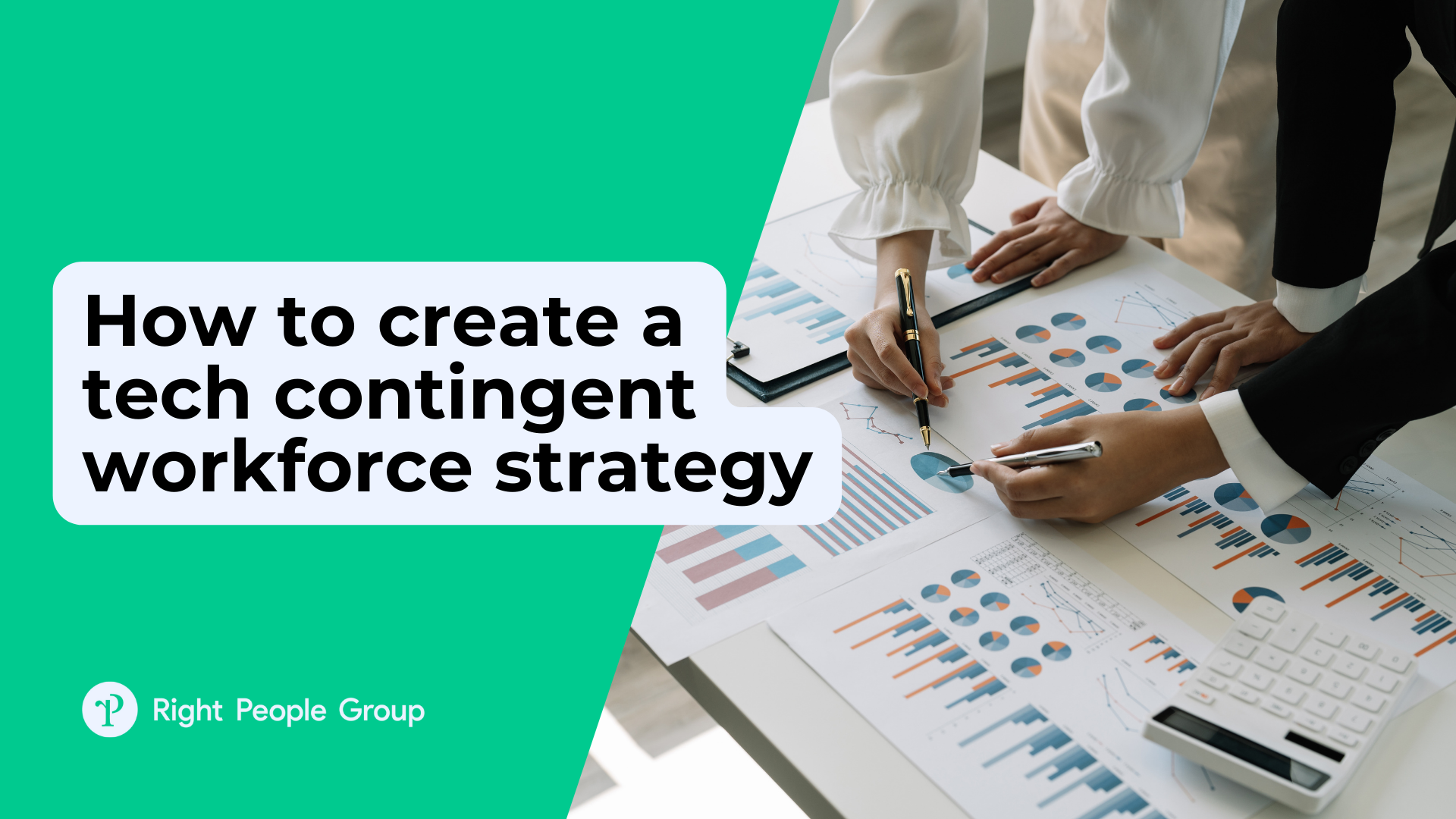There’s a palpable sense of evolution in today’s workforce landscape.
Gone are the days of only having full-time employees handle every aspect of a project. Now, there’s a recognition of the immense value brought by contingent workers. Business are hiring more and more contingent professionals like independent contractors and gig workers who bring a specialized set of skills.
But integrating this new breed of professionals isn’t a straightforward task. It requires a strategy that not only addresses immediate needs but also considers the long-term goals and vision of the company.
This guide offers an in-depth look into how to thoughtfully integrate these talents, ensuring they align with a company’s broader vision in the IT and tech sectors.
1. Analyze current needs
Before jumping into hiring contingent workers, it’s important to thoroughly evaluate your current situation:
Identify the specialized skills that may be lacking among your existing full-time employees. This assessment will help pinpoint where contingent workers can fill the gaps effectively.
Consider any upcoming projects that demand specific expertise not readily available in-house. This foresight ensures that you’re proactively addressing future needs.
2. Collaborate with multiple departments
When crafting a successful contingent workforce strategy, there’s immense value in bringing together your human resources (HR) and procurement departments. Here’s how each contributes:
Human Resources (HR)
Efficient hiring process: HR plays a central role in defining the hiring process for contingent workers. They ensure an efficient path that saves time and resources.
Alignment with company goals: HR professionals are well-versed in your company’s overarching objectives. They ensure that the contingent workforce strategy aligns seamlessly with these broader goals.
Procurement
Cost-effective Contracts: Procurement takes charge of crafting contracts with contingent workers. Their expertise lies in striking the right balance, ensuring that these contracts are not just legally sound but also financially beneficial.
Financial viability: Procurement professionals are like financial gatekeepers. They make sure that every contract entered is an investment with a clear return. Their involvement safeguards the strategy’s financial viability.
Together, HR and procurement create a powerful synergy. HR ensures that the right people are brought in efficiently, while procurement ensures that these engagements make financial sense. This collaboration is pivotal in creating a contingent workforce strategy that not only works but works exceptionally well for your business.
3. Leverage vendor management systems (VMS)
When it comes to handling contingent workers, using a Vendor Management System (VMS) such as the Onsiter VMS can make your life a whole lot easier. Here’s how it adds value:
Smooth collaboration: It lets you work seamlessly with your team. You can easily share important data with them, which is like having all your team members on the same page.
Data privacy assurance: You can rest easy knowing that your hiring process follows GDPR rules. This means you’re taking data privacy seriously, which is crucial in today’s world.
Efficient tracking: Keeping tabs on your contingent workers is a breeze. You can track their work history, timesheets, expenses, and performance metrics with precision. It’s like having a magnifying glass on every aspect of their work.
Time-saving automation: Administrative tasks like negotiating prices and managing digital contracts are automated. This frees up your time for more important things and reduces the risk of errors.
4. Ensure compliance and risk management
When it comes to bringing a contingent worker on board, playing by the rules is non-negotiable.
Why compliance matters
Legal protection: Adhering to local laws and regulations shields your company from legal troubles. You don’t want to end up in a situation where you’re facing fines or lawsuits because you didn’t follow the rules.
Worker well-being: Compliance is about protecting your company and about looking out for the well-being of your contingent labor.
How to stay compliant
Know the rules: Take the time to understand the local laws that pertain to contingent workers. Different regions may have different regulations, so make sure you’re up to date.
Documentation: Keep thorough records of all agreements and contracts with contingent workers. This not only helps with compliance but also ensures clarity in case of any disputes.
Regular audits: Periodically review your contingent workforce management to ensure they still align with the current legal landscape. Don’t assume that what worked a year ago is still compliant today.
Prioritizing compliance and risk management not only safeguards your business but also establishes a safer and more ethical environment for your contingent workforce, benefiting all parties involved.
5. Competitive compensation and benefits
Ensuring that you provide fair pay and attractive perks is a vital part of this strategy. It helps you not only attract top talent but also retain them. Here’s what you need to consider:
Pay rates: To begin, research the market. Understand what consultants with similar skills and experience are earning. This research will guide you in offering a rate that truly reflects their expertise and aligns with industry standards.
Sweeten the deal: While you might not be able to provide the same benefits as your full-time employees (e.g. health insurance), think about offering other incentives like flexible working hours, remote work options, or access to company resources. These perks can turn the scales in your favor if you’re competing against other companies for a consultant’s services.
Create a great place to work: Create a work environment that fosters productivity and well-being. Ensure that consultants have the tools, equipment, and resources they need to perform their best.
Relationship building: Relationships matter. Cultivate a positive and lasting working relationship with your consultants, and they’re likely to work with you again on future projects.
The secret sauce? Communication. Regular check-ins, constructive feedback sessions, and promptly addressing their concerns can foster trust and loyalty that stands the test of time.
6. Regularly evaluate your strategy
In the ever-changing tech landscape, adaptability is your secret weapon. It’s not a “set it and forget it” situation.
Here’s why and how you should consistently assess and fine-tune your contingent workforce strategy:
Why ongoing evaluation is vital:
Tech is dynamic: The tech realm is like a constant whirlwind of innovation. Staying on top of it means regularly checking if your strategy keeps up.
Shifting business goals: Your company’s objectives aren’t etched in stone. They can shift with market trends and customer demands. Your strategy must pivot accordingly.
Worker insights: Your temporary workers are a goldmine of real-world insights. Regular feedback from those on the frontline can unearth opportunities for improvement.
How to do it:
Set review dates: Establish a regular review schedule, whether it’s every few months or annually, to gauge how well your strategy is performing.
KPI analysis: Dive into your key performance indicators (KPIs). These could include project success rates, cost-effectiveness, and worker satisfaction. Are you hitting the mark?
Stay current: Keep your finger on the pulse of industry trends and best practices. Attend conferences, devour tech publications, and connect with peers to stay in the loop.
Nurture worker relationships: Don’t forget to maintain strong connections with your contingent workers. Seek their feedback, embrace their insights, and build a mutually beneficial rapport.
Adapt and enhance: Based on your findings, be prepared to roll up your sleeves and make necessary adjustments. This might entail re-prioritizing, adopting new tools, or refining your hiring and onboarding strategies.
7. Focus on cost savings without compromising quality
When you hire contingent workers, you want to save money but don’t cut corners at the expense of quality.
Here’s how to find that sweet spot between saving cash and getting top-notch work from your contingent workers:
Why balancing cost savings and quality matters:
Budget constraints: Cost savings can help your bottom line, especially when you’re working with tight budgets.
Quality matters: But remember, quality is king. Sacrificing quality can lead to shoddy work and costly mistakes.
How to achieve this balance:
Competitive rates: Offer competitive pay rates to attract skilled contingent workers. This ensures you get the quality you need.
Performance metrics: Set clear performance metrics and expectations. This helps contingent workers understand what you’re looking for in terms of quality.
Regular feedback: Provide feedback to your contingent workers. Constructive criticism can help them improve, ensuring better quality work over time.
Continuous improvement: Focus on continuously improving your contingent workforce strategy. As you fine-tune your approach, you can find better ways to save costs without sacrificing quality.
Quality control: Implement quality control measures to catch and correct any issues early in the project. This prevents costly errors down the line.
8. Manage the entire workforce lifecycle
Efficient management covers every aspect of the contingent workforce journey.
These steps guarantee that your contingent workers not only contribute effectively but also leave with a positive impression, paving the way for future collaborations. This includes:
Informed hiring: It all starts with smart hiring decisions. Know what skills you need and find the right contingent workers who bring them.
Smooth onboarding: A seamless onboarding process sets the stage for success. Equip your new contingent workers with the tools and knowledge they need to excel.
Periodic reviews: Regularly check in on performance. This helps in understanding what’s working well and where improvements are needed.
Structured offboarding: When the contract concludes, ensure a well-structured offboarding. This includes handling final payments, gathering feedback, and maintaining a positive relationship for potential future collaborations.

Managing the entire workforce lifecycle ensures that your contingent workers contribute effectively to your projects and depart on good terms, leaving the door open for future opportunities.
Conclusion
An effective contingent workforce management program can offer flexibility, access to specialized skills, and cost savings. By integrating these practical steps, your business can create a contingent workforce strategy that aligns perfectly with your business goals in the IT and tech sectors.













